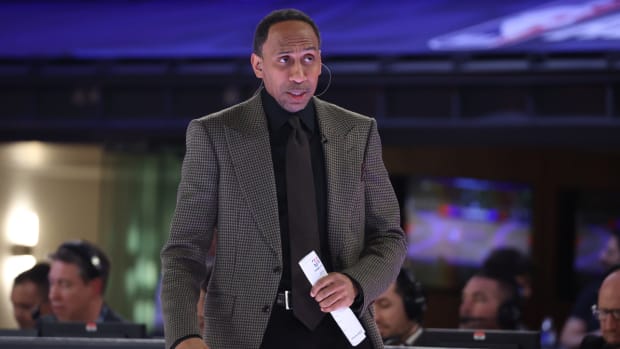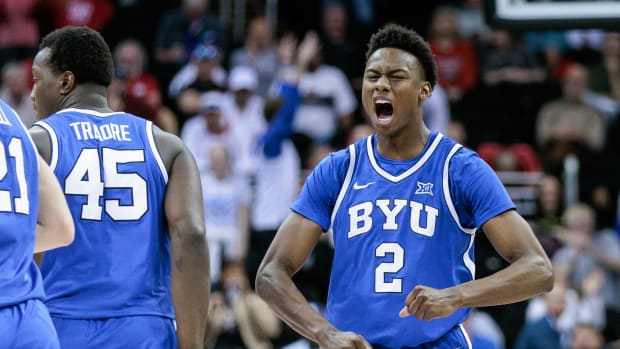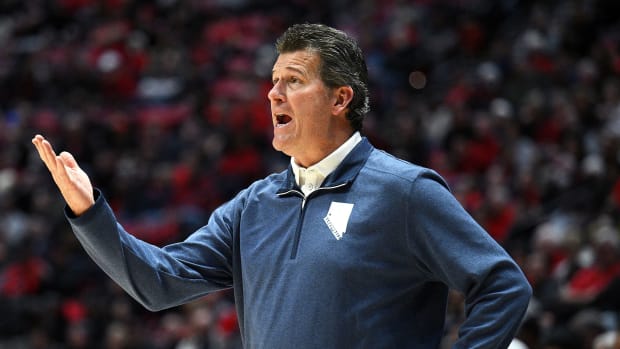Cash-Grabbing Power Players Are Sending College Sports Into a Soulless Spiral
In June 1914, an archduke was assassinated in Sarajevo by a Serbian terrorist. The cascading domino effect far exceeded the historical importance of that single event, leading to more than 17 million people being killed in World War I. It was a catastrophe rooted in disastrous leadership, old grievances, sticky alliances, faulty logic, a lack of foresight and a surplus of hubris.
While obviously not carrying the same tragic stakes, the realignment of college athletics in recent years has been rife with similar dynamics. Universities have blundered wildly into places they shouldn’t have gone, for reasons they cannot adequately articulate. They’ve ridden a wave of the college sports version of nationalism, egged on by greedy TV networks, with panic and delusion superseding calm and reason.
One day, someone fires a pistol at Franz Ferdinand. Next thing you know, there were trenches stretching across the length of France, Americans battling in the mud, Britain invading Turkey.
One day, ESPN is creating the Longhorn Network and causing ripples of discontent in the Big 12. Next thing you know, the Pac-12 is on the verge of being stripped and sold for parts and Florida State’s president is all but declaring secession from the Atlantic Coast Conference.
Where and when it all ends, nobody knows. But eventually, if the Washington Huskies are making their fifth trip east of the fall, on their way to end the regular season in College Park, Md., instead of playing their natural rival in Pullman, there will be a reckoning. The existential questions: “How did we get here? What are we doing? Why did we let this escalate beyond all reason?”
It’s all deeply insulting and hypocritical for a bunch of millionaire leaders who bloviate about “student-athlete welfare,” then assign them geographically ridiculous tasks. The leaders of college athletes don’t care about the athletes, or the fans. They’ll push them both to the breaking point in search of a higher profit margin.

Florida State president Rick McCullough is hungry for a bigger piece of the ACC’s revenue despite the Seminoles posting a 32–32 record in conference play over the last eight years.
Alicia Devine/USA Today Network
The school presidents, athletic directors and conference commissioners all should be ashamed of their role in tearing asunder the fabric of college sports. But they’re too busy taking orders from TV partners and counting the resulting revenue. Yet and still, there is nobody looking out for the greater good of the entire enterprise—nobody willing to throw on the brakes and slow the gravy train.
The hysteria reached a point Wednesday when Florida State leaders publicly fomented a revolution against the ACC in a live-streamed board of trustees meeting. “I believe that FSU will have to, at some point, consider very seriously leaving the ACC, unless there were a radical change to the revenue distribution,” president Rick McCullough said. Trustee Drew Weatherford, a former Seminoles quarterback, took that rhetoric up another notch: “It’s not a matter of if we leave, in my opinion. It’s a matter of how and when we leave.” Another trustee called for an exit plan by 2025.
Consider that FSU is contractually obligated to the ACC for another 11 years beyond ’25. Where the school is going, and how it’s planning to escape a binding grant of rights, remain to be seen. But the FSU stance is clear: the ‘Noles need more money—everyone always needs more money—and are willing to trash any alliances or obligations that stand in the way of that pursuit of cash.
The rest of the ACC is well within its rights to be deeply insulted by this. But Florida State’s perceived status (along with Clemson and maybe Miami) as the football revenue drivers in the league might buy it some appeasement in the form of expediting an uneven revenue split. That’s been discussed earlier this year, but not yet firmed up.
If FSU succeeds in leaving, that throws the entire ACC into turmoil and could be the final step toward some Doomsday Consolidation Consortium. Because Lord knows the Pac-12 is already well down the road to ruin on the other coast.
The demise of the Pac-12—begun last year with the exit of USC and UCLA to the Big Ten—has never been closer to happening. Lightweight member Colorado abandoned for the Big 12 last week, with so-called Four Corners partners Arizona, Arizona State and Utah currently contemplating following the Buffaloes after an underwhelming media-rights agreement was put on the table Tuesday. Then came the news Wednesday afternoon that another two-to-four Pac-12 schools are under preliminary consideration to join the Big Ten: Oregon, Washington, Stanford and California.
The Oregon/Washington part of the equation could be fast-tracked, per sources, with Big Ten media partners factoring into the conversations. “A real proposal is going to take place fast,” a source says. It doesn’t mean a move will come to fruition, necessarily, but there is enough legitimate interest to get it to the proposal stage.
Stanford and Cal are clearly of greater interest to the university presidents than the TV networks—their academic cachet is immense and their location near Silicon Valley and San Francisco is advantageous, while their athletic followings are small and mostly indifferent. But several campus leadership situations are in flux: Ohio State has no president; Northwestern’s president is under fire for his handling of the football hazing investigation; USC’s chancellor is similarly facing scrutiny after the abrupt resignation of athletic director Mike Bohn; Wisconsin’s chancellor has been on the job less than four months. On the other side of the equation, Stanford just accepted the resignation of its president after his scientific research was found to have had “data manipulation” issues.

Big Ten commissioner Tony Petitti, who’s been on the job for less than three months, may hold the future of the Pac-12 (and the Power 5 era) in his hands.
Robert Goddin/USA TODAY Sports
If the Big Ten presidents and chancellors aren’t sufficiently empowered and organized to push for the Bay Area schools they want, this might come down to new commissioner Tony Petitti (a former network TV exec) and the league’s media partners leading the way toward 18 members instead of 20. Perhaps they still stay at 16, but the Pac-12 is fighting some serious negative momentum to even exist.
Does the Big Ten truly want to add those four schools? Like World War I, an escalation elsewhere can trigger involuntary aggression. A Power Five administrator told SI last week: “We’re happy where we are, but we always have to be ready to react. If the Pac-12 falls apart, we might find ourselves considering moves we don’t really want to make, depending on what other leagues are doing.”
It would be massively damaging to college athletics to have no prominent West Coast conference. If an entire region of the country sells out its athletes and fans for a long-distance partnership that in all likelihood would produce fewer victories, greater academic hardship, less tradition and harder travel—all in the name of revenue—the entire enterprise is diminished. More revenue leads to bigger staffs and buildings, makes rich coaches richer, and gives administrators a cushion for financial mismanagement in making hires and rewarding contracts. Those things do nothing for the average fan who wants to win, enjoy local rivalries and maybe make an easy road trip to an away game. They’ve been conned into rooting for revenue, believing that simply being “big time” is some kind of intrinsic reward.
Similarly, the potential bloating of membership in a handful of super conferences—maybe two, maybe three—would create a soulless profit machine that further erodes what makes college athletics different from the NFL and NBA. There would be no point in pretending anymore.
Make the athletes full employees, with unions and revenue shares. Untether football from college altogether, licensing logos and nicknames to businesses that run the teams. How does the Crimson Tide Minor League Football Organization grab you? Wolverines, Inc.? Trojans Football Club? Sounds pretty gross, doesn’t it?
In the heedless, panicky dash for cash, college athletics has sold much of its charm—and the rest is on the auction block to the highest bidder. This World War I-style pileup of circumstances can lead everyone to a barren place they never imagined being, having lost so much along the way.






